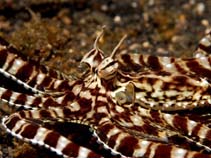Thaumoctopus mimicus Norman & Hochberg, 2005
Mimic octopus| Native range | All suitable habitat | Point map | Year 2050 |

|
| This map was computer-generated and has not yet been reviewed. |
| Thaumoctopus mimicus AquaMaps Data sources: GBIF OBIS |
Classification / Names Common names | Synonyms | CoL | ITIS | WoRMS
Cephalopoda | Octopoda | Octopodidae
Environment: milieu / climate zone / depth range / distribution range Ecology
Benthic; depth range 0 - 37 m (Ref. 96968). Tropical
Distribution Countries | FAO areas | Ecosystems | Occurrences | Introductions
Indo-West Pacific.
Length at first maturity / Size / Weight / Age
Maturity: Lm ? range ? - ? cm Max length : 48.0 cm TL male/unsexed; (Ref. 96968)
Life cycle and mating behavior Maturity | Reproduction | Spawning | Eggs | Fecundity | Larvae
Main reference
References | Coordinator | Collaborators
Norman, M.D. and F.G. Hochberg 2005 The "mimic octopus" (Thaumoctopus mimicus n. gen. et sp.), a new octopus from the tropical Indo-west Pacific (Cephalopoda: Octopodidae). Molluscan Research 25(2):57-70. (Ref. 7940)
IUCN Red List Status
(Ref. 130435: Version 2025-1)
CITES status (Ref. 108899)
CMS (Ref. 116361)
Threat to humans
Human uses
| FishSource |
Tools
More information
Max. ages / sizes
Length-weight rel.
Length-length rel.
Length-frequencies
Mass conversion
Abundance
Internet sources
BHL | BOLD Systems | CISTI | DiscoverLife | FAO(Publication : search) | Fishipedia | GenBank (genome, nucleotide) | GloBI | Gomexsi | Google Books | Google Scholar | Google | PubMed | Tree of Life | Wikipedia (Go, Search) | Zoological Record



